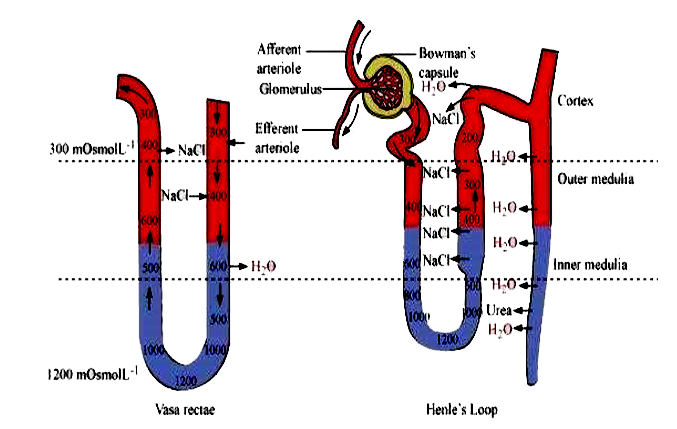COUNTER CURRENT MECHANISM
The counter current mechanism operating inside the kidney is the main adaptation for the conservation of water. There are two counter current mechanisms inside the kidneys. They are Henle’s loop and vasa rectae.
Henle’s loop is a U-shaped part of the nephron. Blood flows in the two limbs of the tube in opposite directions and this gives rise to counter currents. The Vasa recta is an efferent arteriole, which forms a capillary network around the tubules inside the renal medulla. It runs parallel to Henley’s loop and is U-shaped. Blood flows in opposite directions in the two limbs of vasa recta. As a result, blood entering the renal medulla in the descending limb comes in close contact with the outgoing blood in the ascending limb.

The osmolarity increases from 300mOsmolL−1 in the cortex to 1200mOsmolL−1 in the inner medulla by counter current mechanism. It helps in maintaining the concentration gradient, which in turn helps in easy movement of water from collecting tubules. The gradient is a result of the movement of NaCl and urea.
Topper's Solved these Questions
Similar Questions
Read the statements given below
A. The renal cortex extends between the medullary pyramids as Columns of Bertini.
B. ATP molecules are used in kidneys to convert NH3 to urea.
C. Reabsorption of water in PCT and loop of Henle is obligatory.
D. High medullary osmolarity is mainly developed due to NaCI and urea by counter current mechanism of vasa recta and loop of Henle.
The correct statements areView SolutionWhat was Counter Reformation Movement?
View Solution
Knowledge Check
- Question 1 - Select One
Assertion: The kidneys have built in mechanisms for the regulation of lomerular filtration rate (GFR).
Reason: ANF mechanism is one such efficient mechanism.AIf both assertion and reason are true and reason is the correct explanation of assertionBif both assertion and reason are true but reason is not the correct explanation of assertion.Cif assertion is true but reason is falseDif both assertion and reason are false. - Question 2 - Select One
The increase in osmolarity from outer to inner medullary interstitium is maintained due to : (i) Close proximity between Henle's loop and vasa recta (ii) Counter current mechanism (iii) Selective secretion of HCO 3¯ and hydrogen ions in PCT (iv) Higher blood pressure in glomerular capillaries
AOnly(ii)B(iii) and (iv)C(i), (ii) and (iii)D(i) and (ii) - Question 3 - Select One
The increase in osmolarity from outer to inner medullary interstitium is maintained due to : (i) Close proximity between Henle's loop and vasa recta (ii) Counter current mechanism (iii) Selective secretion of HCO 3¯ and hydrogen ions in PCT (iv) Higher blood pressure in glomerular capillaries
A(iii) and (iv)B(i) , (ii) and (iii)C(i) and (ii)DOnly (ii)
Match column I with column II and select the correct option from the codes given below.
Column IColumn IIA. PCT(i). Minimum reabsorptionB. DCT(ii). Filtration of bloodC. Loop of Henle(iii). Reabsorption of 70-80% electrolytesD. Counter current mechanism(iv). Ionic balanceE. Renal corpuscle(v). Maintenance of concentration gradient in medullaView SolutionConsider the following statements and select the correct answer from the codes given below:
Assertion (A): There has been equatorial counter current in every ocean of the world.
Reason (R): Equatorial counter currents are formed by the piling of water in eastern part of the ocean by equatorial currentsView SolutionAssertion :− Feedback mechanism for regulartion of kidney involve hypothalamus & JGA.
Reason :− ANF mechanism check renin-angiotensin mechanism.View SolutionAssertion : Normal urine of man is hypertonic than the blood plasma.
Reason : Counter-current mechanism of loop of Henle and Renin enzyme of juxta-glomerular cells increase the Na+ concentration in the adrenal medulla.View SolutionAssertion :− Human kidneys can produce urine nearly four times concentrated than the initial filtrate formed.
Reason :− Counter current mechanism helps to maintain a concentration gradient in the medullary interstitium.View Solution
